Builders' Forum |
|
| ↓ Scroll to Last Comment ↓ | Forum Guidelines | Builders' Forum | |
We've gotten permission from the Cocktail Class Association to produce a kit for their ridiculously nifty 8-foot racer. It's powered by either a 6hp or 8hp outboard, depending on how much the skipper weighs.
A local naval architect pitched in to help with the conversion from traditional plywood-on-frame construction to stitch-and-glue. We've come up with a pretty cool slot-together scheme. You can assemble the thing in an hour or two, ready for epoxy fillets and fiberglass.
As of this writing five of the CLC-spec hulls have been assembled. The first two weren't "tanked in," and will have to rely on foam for flotation in a swamping. The final version has four separate airtight tanks.
This is one of the old-style Cocktail Class racers, NOT built by CLC, but on display at the WoodenBoat Show a few weeks ago.
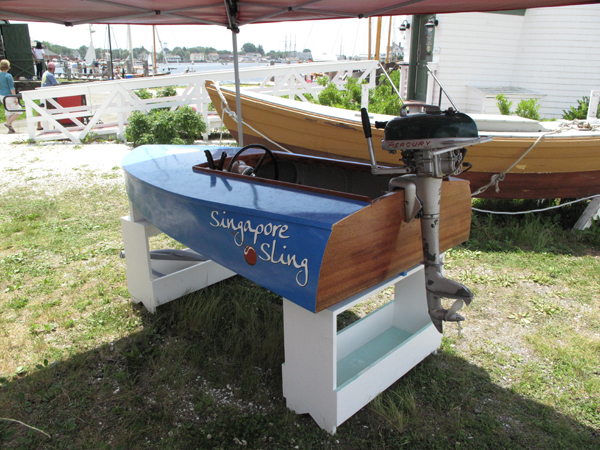
Here's our version.
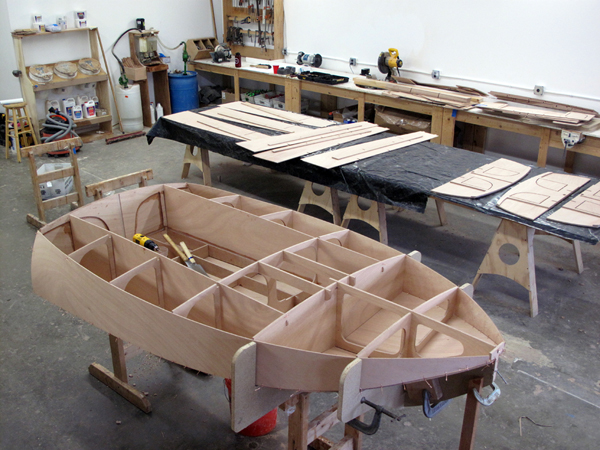
The bow has a lot of shape, so the CLC kit has an external jig clamped to a sawhorse for the bow. Still, beats building upside-down on a "ladder frame" mold!
We have three of them assembled at the moment in the new shop:

The "eggcrate" grid of okoume plywood makes for an incredibly strong and light hull. Finished weight will be in the 60-pound range, and yes, this is a fast little boat on the race course. There's a class minimum weight so water ballast will have to be carried for racing in some circumstances.
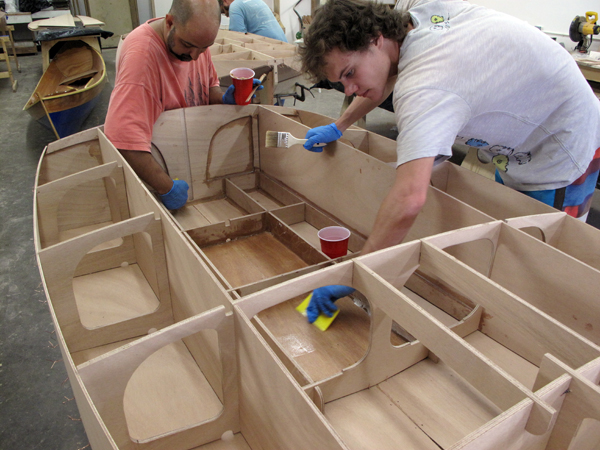
This is one of the very first models, not "tanked in," built by our friend Lee. The plan is to have his on the water this week.
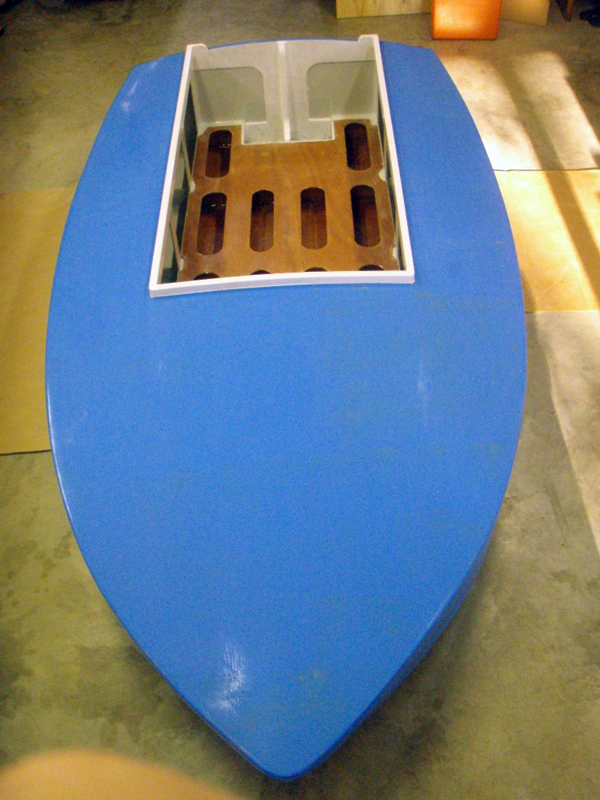
Stay tuned for updates on this kit.
24 replies:
RE: Cocktail Class Racer Project
The History Channel crew filmed a Cocktail Class Racer built by the Edmonds family from a CLC kit. This is the very first of the CLC Cocktail Class kits to hit the water; we're still building prototypes and working on the instruction manual. A few snaps from the on-water film shoot here. Thanks to all of the Edmonds for their hard work on this!
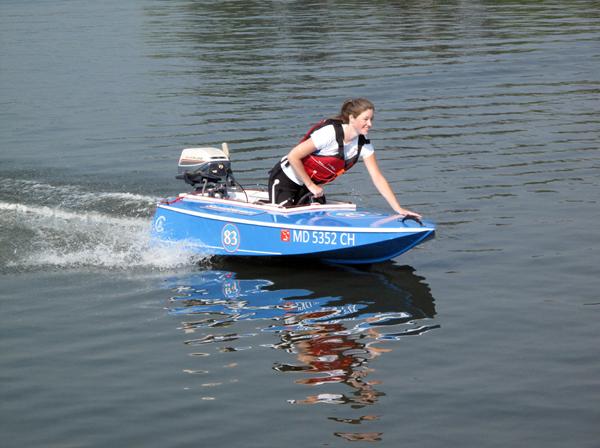
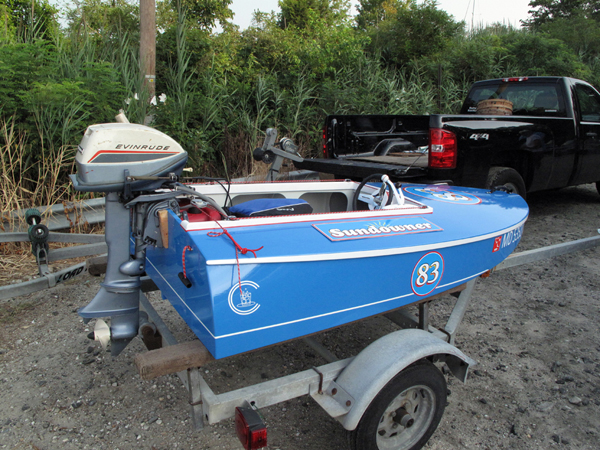
The camera crew from The History Channel, filming the Cocktail Class launch. The DNR Police (boat in the background) were kind enough to run a chase boat for filming. The crew also rigged the boat with a bunch of little onboard digital cams, which ought to make for some cool angles if they use the footage. We'll find out when the show runs.
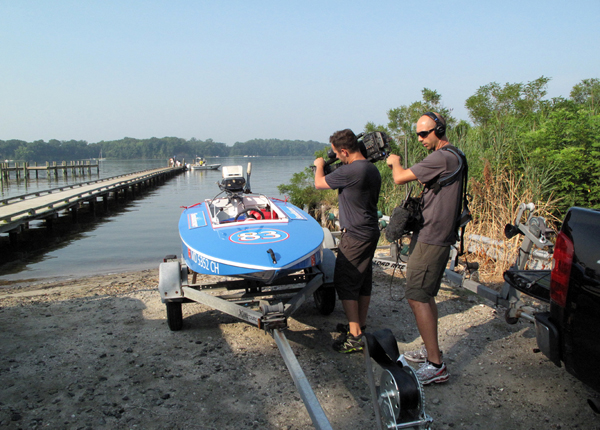
RE: Cocktail Class Racer Project
Per Cocktail Class regs, minimun hull weight is 72 lbs. The 1960-1980 vintage 6-hp OMC outboards weigh about 55 lbs. So driver weight is a significant part of the total. Drivers kneel (no seat) and use their weight to trim and to improve turning efficiency. There is a write-up in the March 2010 Woodenboat magazine.
RE: Cocktail Class Racer Project
Will it be possible to modify this kit to accomodate the drop-in rowing unit? ;)
--
eric
RE: Cocktail Class Racer Project
Piece of cake. With the added benefit of being able to tie the foot rests to the outboard for steering. The only down side is you need to keep your stroke rate near 27-29 strokes per second to stay up on plane. ;)
RE: Cocktail Class Racer Project
Very cool. How easy or difficult is the steering cable / outboard installation for a beginner? And, will the kit instructions offer guidance on this?
RE: Cocktail Class Racer Project
We have a page up for the boat now, though kits are a ways off. Some good construction shots there.
Also a bit of cool on-water video of the Edmonds family BETA version.

RE: Cocktail Class Racer Project
?? I don't get it ... where are the oarlocks? What is that big piece of metal hanging off the back, some kinda trimming device? ;)
RE: Cocktail Class Racer Project
Eric N
Easy. The older OMCs were designed to allow simple remote control of their tiller engines. A standard OMC remote steering bracket, with pulleys, attaches to the front of the outboard's carrying handle with a quarter-turn of a knob. The steering drum is a small piece of PVC coupler and two pieces of 3/4 ply. And the steering mount is some galvanized parts from a hardware store. Throw in a bit of non-stretch dingy line and four microcheek blocks and the steering is almost complete. The old throttle/shift control boxes, cables, and cable fittings can be bought at obscene prices from outboard graveyards, or more reasonably at yard sales or other online venues. There are also new control box units available at reasonable prices, especially compared to what some junkyards are asking. It looks daunting, but isn't with a bit of web help. I don't know what CLC might do with their construction manual, but I expect there will be some discussion of engine hookups. For instant gratification, check out the Cocktail Class website - search for CCWBRA (Cocktail Class Wooden Boat Racing Association). Click on SUPPORT, then look at the steering help. And there is lots of other online help available.
PS I'm looking to get one of these kits, so I might be biased.
RE: Cocktail Class Racer Project
How hard is it to find a working motor that fits within the class rules? How much would you expect to pay for a nice motor that is ready to race?
RE: Cocktail Class Racer Project
How hard is it ... ? If you live somewhere where there isn't any water for motor boating within 1,000 miles, pretty hard. Unless you search ebay or craigslist. If you live somewhere where there are 10,000 lakes within a few hundred miles, pretty easy. Not trying to be flippant, it just depends a bit on your location.
How much $$$ ? A few years ago you could pick up a running motor for $100-150. Now I hear of people spending $200-400, or more, for a running motor. You could be lucky and find someone hoping to locate a boater that will take their grandfather's 6-hp motor out of their barn, not knowing the motor was only used twice and given TLC before being stored for 40 years. Or you might find a running motor for $500 that needs a complete overhaul to be race ready. Buyer beware. The good news is that there really are a lot of motors out there, there are some excellent books detailing how to locate, buy, repair, tune and run them, there are lots of tune-up kits available, and many racers will help newbies set up their rides.
I got a motor for free from my wife's hairdresser. But it'll cost over $500 in parts (free labor) to repair all the damage to the motor caused by rolling on a salty bottom during a storm. If you buy cheap, expect to install a few parts (water pump impeller, points & condenser, thermostat, grease, paint, anything held together with wire, etc.). And while you're at it, inspect cooling passages for blockages and the exhaust for carbon buildup (especially if the motor was used at low speed a lot for trolling using high oil-gas mixture ratios). Winter's coming so it's time to start building. But it's also a good time to carefully go over your motor. If you spend 100 hours building a boat, you should expect to spend more than a few minutes checking you power source. Good luck.
RE: Cocktail Class Racer Project
Here is an easy way to make drum steering..
http://s147.photobucket.com/albums/r302/scrawford_photos/Minimost%20prototypes/


RE: Cocktail Class Racer Project
Thanks for the motor info! What exactly are the class restrictions for the motor? I tried hard to find exact specs on http://www.ccwbra.com/ but everything seemed a bit vague. Will any 2-stroke 8/10hp motor qualify? Or are there more specific brand/year requirements? Are some motors easier to adapt to cable steering than others? I assume a short shaft motor is prefered, is there anything else to be awair of when buying a motor? Thanks again! -Adam
RE: Cocktail Class Racer Project
The latest CCWBRA Membership Racing Handbook states:
“The One Design Class is powered by a stock two stroke Johnson or Evinrude outboard motor with a maximum of 6 horse power and a stock propeller.
The Open Class is powered by a motor of any manufacturer with a maximum of 8 hp.”
Also:
Driver Weight Handicaps:
“6 hp minimum driver weight is 165 pounds. 8 hp minimum driver weight is 200 lbs. Drivers weighing less than the class minimum must carry sufficient weight [ballast] to meet the minimum….”
Note: you can race with less horse power than the class maximum and still have fun!
Short (15”), or sometimes called standard, shaft motors are preferred since the transom is not very tall. Long (20”) or sail (25”) length motors will need to be shortened.
Motors from the ‘50’s and older will need to be examined to determine if remote control is possible, or at least, easy to adapt. Some are only 5.5 hp instead of 6 or 7.5 hp instead of 8. Most OMC 6 hp motors since 1965 allow for remote control and steering hook ups. You may have to purchase or make a standoff to hold the shift cable anchor. Pre-79 OMC motors already have a place on the tiller side for the throttle cable anchor. Later motors use a kit purchased from the manufacturer.
There are other little details that can be researched while waiting for the kits to become boats. For example, the remote control cables may be brand specific or loosening the pilot screw for easier steering. Find a mechanic with an interest in your project. Buy motor parts from him and he may become so interested he’ll build one too! Then you’ll have another racing partner.
RE: Cocktail Class Racer Project
Thanks for the great info! I'm really excited to try this, it looks like so much fun. So a 6hp 2 stroke Johnson from the 80s would qualify for the one design class? I've found one for sale in my area that might be a possibility but I'm hesitatant because most of the motors in the photos look much older, there is no year restriciton? I'm thinking of getting a motor first and working on it while I wait for the kit to be ready. Adam
RE: Cocktail Class Racer Project
Also, what does OMC stand for? Sorry for all the nieve questions, my roots are in sailing so I don't know much about outboards. Thanks again!
RE: Cocktail Class Racer Project
The racing handbook doesn't specify a year, so an 80s Johnson should be okay. OMC stands for Outboard Motor Corporation; covers Evinrude and Johnson outboards.
RE: Cocktail Class Racer Project
Three CLC pre-production Cocktail Class boats placed in the top four positions in the 6-hp class of the CCWBRA Nationals hosted last Saturday by the Rock Hall Yacht Club in Maryland. The paint on one of these top finishers (#40) was still in the can 24 hours before the race. Aaron, one of CLC's boatbuilders took top honors. Sundowner, the first completed pre-production CLC kit and pictured above, tied for first in the 8-hp class, officially placing second (came in second in the last race, the tie breaker).
A short video of some of the racing is up at proptalk.com.
RE: Cocktail Class Racer Project
Hello everyone. My first post here.
I like this project and am looking forward to attending an event and seeing one of these up close. I would like to build one of my own someday. For now I will have to live through the eventures of the fourm.
-Andrew
RE: Cocktail Class Racer Project
Any of these races in or near Michigan? Looks like a great project for a grandpa and grandson. How young are the drivers? The Wood duck 12 and 10 are fun but this really looks like fun!!
Rod
RE: Cocktail Class Racer Project
Why hasn't the design been tweaked so no transom wedge is required for a motor more modern than a 1939? Seems to be too much of a concession to originality for originality's sake!













RE: Cocktail Class Racer Project
» Submitted by fjpatrum - Thu, 7/28/11 » 10:38 AM
That looks like a fun little play boat. The design could easily be extended to a slightly wider 12 or 14 foot model to allow two people to have fun on a lake too.
FrankP